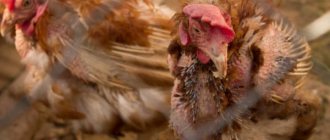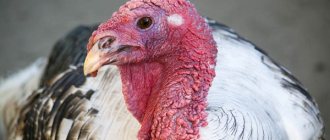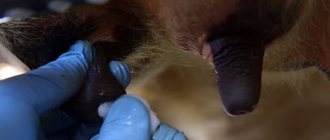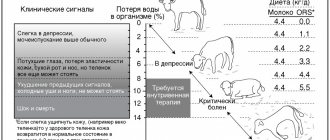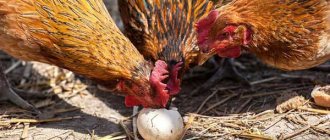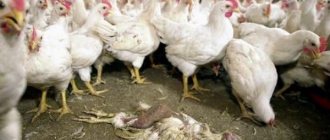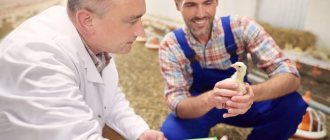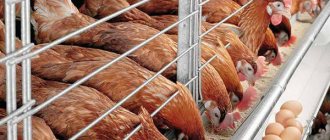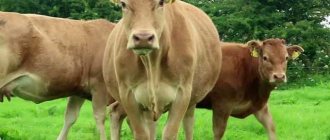How does salmonellosis threaten humans?
Domestic chickens are the most likely to get sick.
Salmonella that enters the human body settles in the small intestine and spreads its waste products - toxins, which provoke:
- diarrhea and dehydration;
- decreased vascular tone;
- nervous system disorders.
There are three forms of salmonellosis in humans:
- Gastrointestinal . Acute course: vomiting and diarrhea, loss of strength, headaches and joint pain, temperature up to 400, limb cramps.
- Typhoid-like . Clinical picture: enlarged liver and spleen, skin rashes, fever, weakness.
- Septic . A short incubation period leads to the development of sepsis.
The complexity of the course of the disease significantly depends on the person’s immunity. A strong body can cope with salmonellosis in 10 days.
Pathological changes
Dissection of dead chickens shows multiple lesions of internal organs, changes at the cellular level in the joint capsules. In mature individuals, deformed, degenerated yolk follicles filled with purulent exudate of a characteristic green color are identified. The gallbladder is swollen, the mucous membranes are scarlet.
When the bacterium enteritidis is identified, its cavity is filled with bile with mucus and fibrin. Bile is olive-colored. In acute and chronic forms, damage to the large intestine is observed, and abnormalities in the cells of the appendix are especially noticeable.
The parenchyma is affected in acute cases. Changes are observed in the mucous tissues of the pulmonary system. The cavity is filled with serous fluid, and there are red, compacted areas on the mucous membranes. Dissection also shows disturbances in the heart muscle, the myocardium is stretched, and the coronary vessels are filled with stagnant blood.
Signs and first symptoms
There are several ways to spread the infection:
- airborne - a day or more passes before the first symptoms appear;
- nutritional infection , manifests itself after about a week.
The rate of development and complexity of salmonellosis depend on the age of the bird.
The hyperacute form is characteristic of newly hatched chicks. The hatched chick only lives for a few hours.
An acute course is detected in chickens that have lived no more than 10 days.
Potential sources of salmonellosis in poultry
Clinical picture in the early stages of the disease:
- lethargy;
- liquid droppings;
- lack of appetite;
- rapid breathing.
The chicks are cold and are located closer to the heat source. Adult birds suffer from salmonellosis in a subacute or chronic form; the symptoms in this case are not so pronounced.
A chicken is infected if it has:
- paws are shaking;
- the temperature rises to 42-43 0C;
- liquid droppings.
A sick bird moves little, grows and develops slowly, and lays fewer eggs.
Symptoms in chicks
Chickens infected with salmonellosis before 2 weeks of age are especially seriously ill; they experience:
- Labored breathing. The bird's beak is constantly open and it wheezes. Mucus is secreted from the nasal openings.
- Weakness , lethargy, inactivity.
- Lack of appetite. As a result, weight is lost and growth is stunted.
- Slow feather growth , atypically sparse plumage.
Be sure to read:
How to cure coccidiosis in broilers: symptoms, treatment and prevention
With weak immunity, the disease progresses quickly. Chickens have drooping wings (paralysis of the limbs), they experience pain, and constantly squeak.
Symptoms in adults
Diagnosing salmonellosis at an early stage is difficult due to the similarity of the first symptoms of the disease to ordinary food poisoning.
Typical signs of salmonellosis are observed only a week after the day of infection.
Typical signs of salmonellosis are observed only a week after the day of infection
Signs of salmonellosis:
- deterioration of vision, coordination of movement;
- wheezing when breathing;
- swelling of the joints in the upper and lower extremities;
- bald spots;
- trembling legs, lameness;
- scallop lethargy;
- the color of the earrings and comb becomes dull;
- green liquid droppings with blood;
- dehydration and thirst;
- decrease in egg production and weight.
Sometimes observed:
- hearing loss;
- goiter atony.
Acute course leads to paralysis of the limbs.
Diagnostics
The symptoms of salmonellosis are similar to those of many other diseases. Therefore, it is not easy to diagnose. There are no distinctive symptoms.
When the symptoms described above appear, laboratory tests are carried out. The blood-droplet reaction method (BDRNG) is used.
Highly productive young animals are diagnosed on the 60th day of life. Laying hens - upon reaching 45% egg production intensity.
1.5 weeks before the study, chickens are no longer given antimicrobial drugs.
To diagnose dead birds, bacterial tests are carried out.
Causes of the disease and pathogen
The causative agent of the infection is a mobile bacterium in the form of a stick curved at the edges, which helps reduce the amount of oxygen and the level of redox reactions in tissues.
Salmonella bacteria
Survives in unfavorable conditions for a long time (in months):
- in soil – up to 10;
- in water – at least 4;
- in smoked or salted meat – up to 3;
- in frozen meat products – up to 5.
Under comfortable conditions, the infection remains viable for 1.5 years.
Birds spread 3 types of salmonella bacteria:
- Enteritidis . _ _ This type of salmonella is adapted specifically to the chicken body. Capable of infecting up to 90% of the entire available livestock. Even with timely treatment, mortality reaches 20%. The infection affects different species of birds and poses a serious danger to humans. The maximum concentration of enteritidis bacteria is detected in the intestines, liver, and ovaries. The disease is difficult to diagnose and often cannot be completely cured.
- Typhimurium ( T yphimurium ) . The clinical picture is similar to that of paratyphoid fever. Typical sites of infection are eggs, oviduct, and liver.
- Pullorum-gallinarum ( Pullorum /Gallinarum ) . Birds suffer the disease quite seriously, in the form of complex gastroenteritis.
The main route of entry for Salmonella is through the mouth when ingesting food or water.
In comfortable conditions, the infection remains viable for 1.5 years
The presence of the following factors creates a fertile environment for the development of salmonellosis:
- sudden changes in temperature;
- poor quality cleaning of premises;
- other avian diseases;
- weakened immune system;
- bird density is higher than established standards;
- walking in areas with stagnant water.
In isolated spaces, the infection spreads through airborne droplets. Eggs become infected from sick laying hens, then they end up in an incubator where the bacteria spread to other eggs.
State control
As already noted, salmonellosis is under constant control by government agencies. In the poultry industry, the program to combat salmonellosis includes several areas.
- Bacteriological control of Salmonella carriage in parent flocks and industrial flocks of laying hens and meat poultry.
- Bacteriological control of the condition of hatcheries.
- Bacteriological control of feed and drinking water entering the farm.
- Laboratory control of each batch of products at meat processing plants. Quality control of daily disinfection after the end of the work shift.
- Research on pullorosis-typhoid fever in the KRNGA of breeding young chickens at the age of 55 days with subsequent culling of positively reacting individuals.
- Tests for salmonellosis are required when obtaining a product certificate. Bacteriological examinations are also required when drawing up veterinary documents for permission to engage in the production and processing of farm products, delivering poultry for slaughter, and sending finished poultry products to retail chains.
- All employees of poultry and meat processing enterprises are required to undergo an annual medical examination, including testing for salmonellosis. People who come to shift with signs of respiratory or intestinal infections are not allowed to work.
Sanctions of veterinary services
In farms unaffected by salmonellosis, restrictions are introduced. The sale of live poultry, hatching eggs, down and feathers is stopped. Meat from chickens suffering from salmonellosis is prohibited from being sold in public catering chains.
At slaughter, the affected internal organs are disposed of, and the carcasses are boiled for 2.5 hours or sent for the production of canned food. If there are changes in the muscles, the bird carcasses are disposed of. Eggs obtained from disadvantaged flocks are sent to food factories that produce high-temperature processed confectionery and bakery products. It is prohibited to make melange and egg powder from such eggs.
Restrictions on the farm are lifted after a double laboratory test for salmonella carriage, as well as three months after the last case of the disease.
The course of salmonellosis in chickens
The following factors influence the severity of the disease:
- age of the bird;
- what type of salmonellosis does the individual suffer from;
- conditions of its detention;
- concomitant diseases and immunity of a particular individual.
A resistant and strong body in direct contact with infection is able to resist the development of the disease and remain healthy.
Be sure to read:
How to get rid of chicken lice using folk and chemical means
Course of the disease in geese and ducks
The body of waterfowl is less resistant to salmonellosis than that of chickens. Young animals, whose life expectancy does not exceed 15 days, quickly lose the ability to continue to exist.
Signs of salmonellosis in goslings are observed after 2-3 days from the day of infection, in ducklings - after 3-6 days.
Chicks suffer:
- lack of appetite;
- constant diarrhea;
- difficulty breathing;
- copious discharge from the eyes;
- lameness.
Ducklings and goslings lie on their sides, their wings sag, their paws swell, and quickly weaken. Infection in newly hatched chicks appears within 12 hours. In the absence of proper treatment, the young animals die within a day.
Ducklings and goslings lie on their sides, their wings sag, their paws swell, and quickly weaken.
Ducks and geese that have reached the age of two months suffer from a chronic, mild form of salmonellosis.
You should be concerned if your birds:
- growth and weight gain slows down;
- systematic intestinal disorder.
Laying hens often suffer from yolk peritonitis, which usually ends in death.
Salmonellosis in other poultry species
The disease in turkeys varies depending on the age of the bird:
- Chicks that live no more than 10 days die in almost 100% of cases.
- Adults with appropriate treatment almost always survive. General symptoms of the disease are exhaustion, diarrhea, swelling of the legs. After treatment, they remain carriers of infection for a long time.
Pigeons are difficult to tolerate infection. In addition to typical symptoms, they experience:
- nodules on the joints;
- convulsions;
- loss of vision;
- impaired coordination;
- neck paralysis;
- lack of ability to fly.
Mortality among infected pigeons approaches 100%.
Methods for treating salmonellosis
It begins with isolating an individual with symptoms of poisoning for 20 days. During this period, tests are carried out for the presence of salmonella in the blood. If no salmonella is detected, then the bird is considered healthy and is returned to its brethren.
For the rest of the livestock, preventive measures are provided:
- strengthening veterinary control;
- adding antibiotics and bifidobacteria to feed;
- feeding the chicks, immediately after hatching, with probiotics;
- treatment of premises, cages and eggs with antiseptic compounds;
- disinfestation of feeders and drinkers.
Drug therapy
Treatment of salmonellosis is carried out comprehensively.
It is based on the use of antibacterial drugs, which are used in the form of:
- powder added to food or water;
- intramuscular injections.
The dosage is determined by the age, weight and breed of the bird.
Effective antibiotics and how to use them:
- Levomycetin . Give 3 times a day, in the amount of 30 g per 1 kg of weight. Duration - a week.
- Baytril . Dilute in water, for each liter - 0.5 ml of the drug. The birds are not given clean water at this time. Course – 5 days.
- Gentamicin sulfate . Solution concentration: 5 mg per 10 liters of water. Course – 5-7 days.
- Furazolidone . Dilute in water, 1 tablet for every 3 liters. At the same time, streptomycin is added to the feed (1 thousand units per 1 kg). Duration – 20 days.
Be sure to read:
Why do chickens go bald on their back, neck, head: causes, symptoms and treatment?
To maintain microflora in the stomach and intestines during treatment, probiotics are added to the birds' feed.
Salmonella bacteria adapt to the effects of antibiotics and become increasingly resistant over time, so it is not always possible to cure a bird.
Therapy is effective only at the early stage of salmonellosis. Individuals with obvious signs of infection are slaughtered and their bodies are disposed of.
Traditional methods
Salmonella bacteria adapt to the effects of antibiotics
Natural remedies cannot kill salmonella bacteria on their own. But the simultaneous use of traditional and professional treatment methods allows you to quickly cope with the disease.
The following are considered effective:
- Infusion of flowers of calendula, chamomile, yarrow . Brew 1 tsp in 0.2 liters of boiling water. mixtures of herbs. Feed the birds 3 times a day. The infusion has anti-inflammatory, cleaning and disinfecting effects.
- Oak bark decoction . Indicated for diarrhea, a good antiseptic. Brew a spoonful of dry bark in a glass of boiling water and cook for 10 minutes over low heat. Give 3 times a day.
- Infusion of bird cherry fruits . 10 g of dry berries are dipped in boiling water and kept in a water bath for 20 minutes. For diarrhea, give on an empty stomach.
Herbal infusions have virtually no contraindications. The duration of treatment with them is determined by the condition of the bird; they are recommended until complete restoration of health.
Prevention
In order to prevent the development of salmonellosis, the following preventive measures must be taken:
- Feed and water are treated with antibiotics.
- They organize sanitary checkpoints that protect the chicken coop from the introduction of diseases from other people's poultry houses.
- Nests and eggs are disinfected.
- Regularly clean the premises and ensure the cleanliness of feeders and drinkers.
- Burn and dispose of all waste after incubation.
- From the first feeding, young individuals are given prebiotics.
At the same time, vaccines are used to prevent the disease. They are mandatory on those farms where a dangerous disease has already been identified. The following medications are used:
- Salmokron.
- Avivak-Salmovak.
- Salmabik plus.
Only medications prescribed by the veterinarian are administered.

